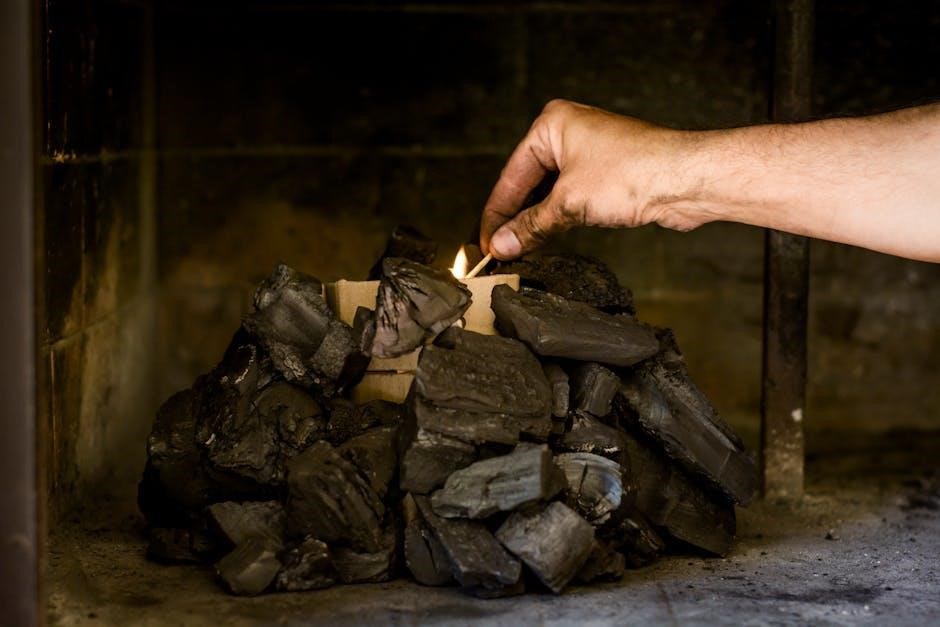Welcome to the Atwood Carbon Monoxide Detector Manual. This guide provides essential information for understanding and using your Atwood Carbon Monoxide Detector effectively. It ensures safety by detailing installation‚ operation‚ and maintenance procedures to help you protect your RV environment from potential gas hazards.
1.1 Overview of the Atwood Carbon Monoxide Detector
The Atwood Carbon Monoxide Detector is a key safety device designed to detect dangerous levels of propane and carbon monoxide in RV environments. It features multiple LED indicators for power‚ propane‚ carbon monoxide‚ and faults‚ along with an audible alarm to alert users of potential hazards. The detector includes a rest/test button for functionality checks and is built to last with a typical lifespan of seven years. Proper installation and regular maintenance ensure reliable performance‚ crucial for protecting against combustion-related risks.

1.2 Importance of Understanding the Manual

Understanding the Atwood Carbon Monoxide Detector Manual is crucial for ensuring the device functions correctly and provides reliable protection. The manual outlines essential safety features‚ operation procedures‚ and maintenance requirements. It helps users interpret LED indicators‚ audible alarms‚ and fault signals‚ enabling prompt responses to potential hazards. Proper comprehension of the manual ensures the detector operates effectively‚ safeguarding against propane and carbon monoxide risks. Neglecting to follow the guidelines may lead to reduced device performance or safety risks‚ making it vital to thoroughly review and understand the provided instructions.
Key Features of the Atwood Carbon Monoxide Detector
The Atwood Carbon Monoxide Detector features a Power LED‚ Propane LED‚ Carbon Monoxide LED‚ and Fault LED for status indication. It also includes an Audible Indicator for alarms‚ ensuring clear notifications of potential hazards.
2.1 Power LED Indicator
The Power LED Indicator on the Atwood Carbon Monoxide Detector shows the system’s power status. When the detector is powered on‚ the LED lights up‚ indicating proper operation. If the LED is off‚ it signals a power supply issue. This feature ensures users are aware of the detector’s operational status at all times. Always check the power connection if the LED does not illuminate. This indicator is crucial for verifying that the detector is functioning and ready to alert you in case of hazards. Regular checks of this LED can help maintain safety in your RV environment.

2.2 Propane LED Indicator
The Propane LED Indicator on the Atwood Carbon Monoxide Detector monitors propane gas levels. When propane is detected‚ the LED flashes to alert you of a potential hazard. If no propane is present‚ the LED remains off. This feature ensures early detection of propane leaks‚ allowing you to take immediate action. The LED also indicates the detector’s operational status for propane sensing. Always monitor this light to stay informed about your RV’s propane levels and ensure a safe environment. Regular checks of this indicator can prevent dangerous situations related to propane gas leaks.
2.3 Carbon Monoxide LED Indicator
The Carbon Monoxide LED Indicator is a critical feature of the Atwood Carbon Monoxide Detector. This LED monitors carbon monoxide levels in the air. When dangerous levels of CO are detected‚ the LED flashes rapidly to alert you. If no CO is present‚ the LED remains off. A steady light indicates normal operation. The LED also signals the detector’s end-of-life by flashing continuously. Always monitor this indicator to ensure your safety. If the LED flashes for CO‚ ventilate the area immediately and follow emergency procedures. Regular testing ensures the LED functions correctly‚ providing reliable protection against carbon monoxide hazards.
2.4 Fault LED Indicator
The Fault LED Indicator on the Atwood Carbon Monoxide Detector alerts you to system malfunctions. This LED lights up when the detector detects internal issues‚ such as a power supply fault or sensor failure. A flashing Fault LED indicates a specific error‚ while a steady light signals a critical system failure. If the Fault LED activates‚ check the power connections and ensure proper installation. If the issue persists‚ the detector may need replacement. Monitoring this indicator ensures your device operates correctly‚ providing reliable protection against gas hazards. Always address Fault LED alerts promptly to maintain safety.
2.5 Audible Indicator
The Audible Indicator on the Atwood Carbon Monoxide Detector provides crucial audio alerts for potential hazards. It emits a loud‚ high-pitched beep when detecting dangerous levels of propane or carbon monoxide. The alarm sounds continuously until the threat is resolved. Additionally‚ the Audible Indicator may beep intermittently to signal the detector’s end-of-life or a system fault. Always investigate the cause of the beep promptly‚ as it indicates a need for action. Refer to the troubleshooting section for guidance on addressing beeping issues. This feature ensures you are alerted to potential dangers‚ even when you are not visually monitoring the detector.

Installation and Setup
Proper installation is crucial for the Atwood Carbon Monoxide Detector’s functionality. Choose a location with good air circulation‚ ensure correct wiring‚ and secure the detector firmly. Follow the manual’s guidelines for power supply connections and mounting to guarantee accurate gas detection and reliable performance. This ensures your safety and the detector’s efficiency in monitoring potential hazards. Always double-check connections and placement before finalizing the setup. A well-installed detector provides peace of mind and effective protection against gas threats. Refer to the manual for detailed step-by-step instructions to avoid installation errors. Ensure all safety precautions are followed to maintain optimal functionality. Proper installation is the foundation of reliable gas detection. Avoid areas with direct sunlight or moisture to prevent interference. Use the provided hardware for secure mounting. Test the detector after installation to confirm it is working correctly. This step is vital to ensure your safety and the device’s effectiveness. By following the installation guide‚ you can trust the detector to alert you to potential dangers. A correct setup ensures the Audible Indicator and LED lights function as intended. Take your time during installation to avoid any issues. Your safety depends on it. Always refer to the manual for specific instructions tailored to your detector model. If unsure‚ consult a professional for assistance; A proper installation ensures the detector operates within its designed specifications. Never skip steps outlined in the manual‚ as they are critical for accurate gas detection. The detector’s performance relies heavily on correct installation practices. Ensure the power supply is stable and meets the detector’s requirements. Secure all wires to prevent loose connections. Mount the detector at the recommended height to ensure accurate gas sensing. Avoid areas near vents or doors to prevent false readings. Test the detector after installation to confirm it is functioning properly. This step is essential to ensure your safety and the detector’s reliability. A well-installed detector provides consistent and accurate gas monitoring. Always follow the manufacturer’s guidelines for installation and setup. Your safety is the top priority‚ and proper installation ensures the detector works as intended. Take the time to do it right and avoid potential risks. The detector’s effectiveness depends on a correct and secure installation. Never overlook the importance of proper setup. It is crucial for the detector’s performance and your safety. Always double-check your work to ensure everything is correctly installed. A properly installed detector is your first line of defense against gas hazards. Trust the process and follow the manual carefully. Your safety is worth the extra effort. A correct installation ensures the detector operates efficiently and reliably. Never compromise on the setup process‚ as it directly impacts the detector’s ability to protect you. Always prioritize proper installation to maintain your safety and the detector’s functionality. The detector’s performance is only as good as its installation. Take the necessary steps to ensure it is set up correctly. Your safety depends on it. A well-installed detector provides peace of mind and effective protection. Always follow the manual’s instructions for installation and setup. Proper installation is the key to reliable gas detection and your safety. Never skip or rush through the installation process. It is essential for the detector’s functionality. A correct setup ensures the detector works as intended‚ providing accurate alerts and reliable protection. Always refer to the manual for specific installation requirements. Your safety is the top priority‚ and proper installation ensures the detector is ready to protect you. Take the time to install it correctly and avoid potential risks. A properly installed detector is your best defense against gas hazards. Trust the process and follow the manual carefully. Your safety is worth the extra effort. A correct installation ensures the detector operates efficiently and reliably. Never compromise on the setup process‚ as it directly impacts the detector’s ability to protect you. Always prioritize proper installation to maintain your safety and the detector’s functionality. The detector’s performance is only as good as its installation. Take the necessary steps to ensure it is set up correctly. Your safety depends on it. A well-installed detector provides peace of mind and effective protection. Always follow the manual’s instructions for installation and setup. Proper installation is the key to reliable gas detection and your safety. Never skip or rush through the installation process. It is essential for the detector’s functionality. A correct setup ensures the detector works as intended‚ providing accurate alerts and reliable protection. Always refer to the manual for specific installation requirements. Your safety is the top priority‚ and proper installation ensures the detector is ready to protect you. Take the time to install it correctly and avoid potential risks. A properly installed detector is your best defense against gas hazards. Trust the process and follow the manual carefully. Your safety is worth the extra effort. A correct installation ensures the detector operates efficiently and reliably. Never compromise on the setup process‚ as it directly impacts the detector’s ability to protect you. Always prioritize proper installation to maintain your safety and the detector’s functionality. The detector’s performance is only as good as its installation. Take the necessary steps to ensure it is set up correctly. Your safety depends on it. A well-installed detector provides peace of mind and effective protection. Always follow the manual’s instructions for installation and setup. Proper installation is the key to reliable gas detection and your safety. Never skip or rush through the installation process. It is essential for the detector’s functionality. A correct setup ensures the detector works as intended‚ providing accurate alerts and reliable protection. Always refer to the manual for specific installation requirements. Your safety is the top priority‚ and proper installation ensures the detector is ready to protect you. Take the time to install it correctly and avoid potential risks. A properly installed detector is your best defense against gas hazards. Trust the process and follow the manual carefully. Your safety is worth the extra effort. A correct installation ensures the detector operates efficiently and reliably. Never compromise on the setup process‚ as it directly impacts the detector’s ability to protect you. Always prioritize proper installation to maintain your safety and the detector’s functionality. The detector’s performance is only as good as its installation. Take the necessary steps to ensure it is set up correctly. Your safety depends on it. A well-installed detector provides peace of mind and effective protection. Always follow the manual’s instructions for installation and setup. Proper installation is the key to reliable gas detection and your safety. Never skip or rush through the installation process. It is essential for the detector’s functionality. A correct setup ensures the detector works as intended‚ providing accurate alerts and reliable protection. Always refer to the manual for specific installation requirements. Your safety is the top priority‚ and proper installation ensures the detector is ready to protect you. Take the time to install it correctly and avoid potential risks. A properly installed detector is your best defense against gas hazards. Trust the process and follow the manual carefully. Your safety is worth the extra effort. A correct installation ensures the detector operates efficiently and reliably. Never compromise on the setup process‚ as it directly impacts the detector’s ability to protect you. Always prioritize proper installation to maintain your safety and the detector’s functionality. The detector’s performance is only as good as its installation. Take the necessary steps to ensure it is set up correctly. Your safety depends on it. A well-installed detector provides peace of mind and effective protection. Always follow the manual’s instructions for installation and setup. Proper installation is the key to reliable gas detection and your safety. Never skip or rush through the installation process. It is essential for the detector’s functionality. A correct setup ensures the detector works as intended‚ providing accurate alerts and reliable protection. Always refer to the manual for specific installation requirements. Your safety is the top priority‚ and proper installation ensures the detector is ready to protect you. Take the time to install it correctly and avoid potential risks. A properly installed detector is your best defense against gas hazards. Trust the process and follow the manual carefully. Your safety is worth the extra effort. A correct installation ensures the detector operates efficiently and reliably. Never compromise on the setup process‚ as it directly impacts the detector’s ability to protect you. Always prioritize proper installation to maintain your safety and the detector’s functionality. The detector’s performance is only as good as its installation. Take the necessary steps to ensure it is set up correctly. Your safety depends on it. A well-installed detector provides peace of mind and effective protection. Always follow the manual’s instructions for installation and setup. Proper installation is the key to reliable gas detection and your safety. Never skip or rush through the installation process. It is essential for the detector’s functionality. A correct setup ensures the detector works as intended‚ providing accurate alerts and reliable protection. Always refer
3.1 Choosing the Right Location
Proper placement of the Atwood Carbon Monoxide Detector is crucial for accurate gas detection. Mount the detector at least 5 feet off the floor to avoid ground-level interference. Ensure it is positioned in areas with good air circulation to prevent false readings. Avoid installing near direct sunlight‚ moisture‚ or vents‚ as these can affect sensor accuracy. Place the detector in high-occupancy areas‚ such as sleeping quarters‚ to maximize safety. Follow the manual’s guidelines to ensure optimal performance and reliable alerts.
3.2 Wiring and Power Supply

The Atwood Carbon Monoxide Detector requires a stable 12V DC power supply. Connect the detector to your RV’s electrical system‚ ensuring proper wiring to avoid electrical interference. Use the correct wire gauge and maintain consistent voltage to prevent malfunctions. Avoid connecting to circuits that may experience power fluctuations. The detector should be powered continuously to ensure constant monitoring. If unsure‚ consult a professional for safe installation. Proper wiring ensures reliable performance and accurate gas detection‚ safeguarding your RV environment from potential hazards. Always follow the manual’s wiring guidelines for optimal functionality.
3.3 Mounting the Detector
Mount the Atwood Carbon Monoxide Detector in a location that ensures accurate gas detection‚ typically near the floor‚ as carbon monoxide and propane gases are denser than air. Use the provided mounting hardware to secure the detector firmly to the wall or surface. Ensure the detector is level and avoid installing it near vents‚ doors‚ or windows‚ as airflow may interfere with sensor accuracy. The trim ring should be installed to conceal any gaps‚ ensuring a flush and secure fit. Refer to the manual for specific mounting height recommendations to optimize performance and safety in your RV. Proper mounting is crucial for reliable gas detection.
Maintenance and Testing
Regular maintenance ensures the detector functions correctly. Clean the sensor monthly and test the alarm using the rest/test button. Replace batteries or check wiring as needed.
4.1 Cleaning the Detector
Regular cleaning is crucial for maintaining the detector’s accuracy. Use a soft‚ dry cloth to wipe the exterior and sensor. Avoid harsh chemicals or abrasive materials‚ as they may damage the unit. Gently remove dust or debris that could interfere with gas detection. For stubborn stains‚ lightly dampen the cloth with water‚ but ensure no moisture enters the sensor openings. Cleaning should be done monthly or as needed to prevent false alarms. Proper maintenance ensures reliable performance and extends the detector’s lifespan. Always follow these steps to keep your Atwood detector functioning optimally.

4.2 Testing the Detector
Testing the Atwood Carbon Monoxide Detector ensures it functions correctly. Locate the test button on the top right of the unit. Press and hold it to activate the test mode. The LEDs will flash‚ and the audible alarm will sound‚ confirming proper operation. This test verifies the power supply‚ sensor‚ and alarm functionality. Perform this test monthly to ensure reliability. If the alarm does not sound or LEDs do not flash‚ the detector may require maintenance or replacement. Regular testing is crucial for maintaining safety and ensuring early detection of hazardous gas levels in your RV.
4.3 Resetting the Detector
To reset the Atwood Carbon Monoxide Detector‚ press and hold the test/reset button located on the top right of the unit. Hold it for 5-10 seconds until the LEDs stop flashing and the audible alarm ceases. This resets the detector to its normal operating state. If the detector is at its end-of-life‚ resetting will not work‚ and replacement is required. Always refer to the manual for specific reset procedures‚ as improper resetting may lead to inaccurate gas detection. Regular resets ensure the detector remains functional and reliable for continuous safety monitoring in your RV environment.

Troubleshooting Common Issues
Identify and resolve issues with your Atwood detector by checking error codes‚ LED flash patterns‚ and audible alerts. Use the test/reset button to address false alarms or faults. If issues persist‚ refer to the manual for detailed solutions or consider replacing the detector if it has reached its end-of-life phase. Regular troubleshooting ensures optimal performance and safety in detecting propane and carbon monoxide levels in your RV environment. Always prioritize safety when addressing detector malfunctions or alarms. Consult the manual for specific error code meanings and resolution steps to maintain reliable gas detection. If unsure‚ seek professional assistance to avoid potential hazards. Ensure all troubleshooting steps are followed carefully to prevent further complications and ensure the detector operates correctly. By addressing issues promptly‚ you can maintain a safe and secure environment within your RV. Remember‚ a functioning detector is crucial for protecting against gas leaks and carbon monoxide exposure. Never ignore persistent alarms or malfunctions‚ as they may indicate a serious safety risk. Always follow the manufacturer’s guidelines for troubleshooting to ensure effectiveness and reliability. If the detector is at its end-of-life‚ replace it immediately to maintain continuous protection. Troubleshooting common issues ensures your Atwood detector remains a trusted safeguard against gas hazards. Stay proactive in monitoring and addressing any problems to uphold safety standards in your RV. Regular checks and timely resolutions are key to preventing potential dangers associated with gas leaks and carbon monoxide exposure. Keep your Atwood detector in optimal condition by adhering to troubleshooting procedures outlined in this manual. Your safety depends on it. Always prioritize the proper functioning of your Atwood Carbon Monoxide Detector to ensure a safe living environment. If troubleshooting does not resolve the issue‚ contact a professional for further assistance. Remember‚ a malfunctioning detector can lead to serious safety risks‚ so never delay in addressing problems. By following the troubleshooting guide‚ you can extend the life of your detector and maintain its reliability. Stay informed and take action promptly to keep your RV safe from gas hazards. Troubleshooting common issues is a vital part of maintaining your Atwood detector’s effectiveness and ensuring your safety. Always refer to the manual for guidance on resolving detector issues. If the problem persists‚ consider replacing the detector to avoid any risks. Your safety is paramount‚ so never overlook the importance of a properly functioning carbon monoxide detector. Troubleshooting common issues ensures your Atwood detector continues to protect you from potential gas hazards. Stay vigilant and proactive in maintaining your detector’s performance. If troubleshooting steps do not resolve the issue‚ seek professional help to ensure your safety. Remember‚ a reliable detector is your first line of defense against carbon monoxide and propane leaks. Always address troubleshooting issues promptly to maintain a safe environment. If the detector is not functioning correctly‚ replace it immediately to avoid any risks. Your safety is worth the investment in a reliable carbon monoxide detector. Troubleshooting common issues ensures your Atwood detector remains a trusted safeguard against gas hazards. Stay proactive in monitoring and addressing any problems to uphold safety standards in your RV. Regular checks and timely resolutions are key to preventing potential dangers associated with gas leaks and carbon monoxide exposure. Keep your Atwood detector in optimal condition by adhering to troubleshooting procedures outlined in this manual. Your safety depends on it. Always prioritize the proper functioning of your Atwood Carbon Monoxide Detector to ensure a safe living environment. If troubleshooting does not resolve the issue‚ contact a professional for further assistance. Remember‚ a malfunctioning detector can lead to serious safety risks‚ so never delay in addressing problems. By following the troubleshooting guide‚ you can extend the life of your detector and maintain its reliability. Stay informed and take action promptly to keep your RV safe from gas hazards. Troubleshooting common issues is a vital part of maintaining your Atwood detector’s effectiveness and ensuring your safety. Always refer to the manual for guidance on resolving detector issues. If the problem persists‚ consider replacing the detector to avoid any risks. Your safety is paramount‚ so never overlook the importance of a properly functioning carbon monoxide detector. Troubleshooting common issues ensures your Atwood detector continues to protect you from potential gas hazards. Stay vigilant and proactive in maintaining your detector’s performance. If troubleshooting steps do not resolve the issue‚ seek professional help to ensure your safety. Remember‚ a reliable detector is your first line of defense against carbon monoxide and propane leaks. Always address troubleshooting issues promptly to maintain a safe environment. If the detector is not functioning correctly‚ replace it immediately to avoid any risks. Your safety is worth the investment in a reliable carbon monoxide detector. Troubleshooting common issues ensures your Atwood detector remains a trusted safeguard against gas hazards. Stay proactive in monitoring and addressing any problems to uphold safety standards in your RV. Regular checks and timely resolutions are key to preventing potential dangers associated with gas leaks and carbon monoxide exposure. Keep your Atwood detector in optimal condition by adhering to troubleshooting procedures outlined in this manual. Your safety depends on it. Always prioritize the proper functioning of your Atwood Carbon Monoxide Detector to ensure a safe living environment. If troubleshooting does not resolve the issue‚ contact a professional for further assistance. Remember‚ a malfunctioning detector can lead to serious safety risks‚ so never delay in addressing problems. By following the troubleshooting guide‚ you can extend the life of your detector and maintain its reliability. Stay informed and take action promptly to keep your RV safe from gas hazards. Troubleshooting common issues is a vital part of maintaining your Atwood detector’s effectiveness and ensuring your safety. Always refer to the manual for guidance on resolving detector issues. If the problem persists‚ consider replacing the detector to avoid any risks. Your safety is paramount‚ so never overlook the importance of a properly functioning carbon monoxide detector. Troubleshooting common issues ensures your Atwood detector continues to protect you from potential gas hazards. Stay vigilant and proactive in maintaining your detector’s performance. If troubleshooting steps do not resolve the issue‚ seek professional help to ensure your safety. Remember‚ a reliable detector is your first line of defense against carbon monoxide and propane leaks. Always address troubleshooting issues promptly to maintain a safe environment. If the detector is not functioning correctly‚ replace it immediately to avoid any risks. Your safety is worth the investment in a reliable carbon monoxide detector. Troubleshooting common issues ensures your Atwood detector remains a trusted safeguard against gas hazards. Stay proactive in monitoring and addressing any problems to uphold safety standards in your RV. Regular checks and timely resolutions are key to preventing potential dangers associated with gas leaks and carbon monoxide exposure. Keep your Atwood detector in optimal condition by adhering to troubleshooting procedures outlined in this manual. Your safety depends on it. Always prioritize the proper functioning of your Atwood Carbon Monoxide Detector to ensure a safe living environment. If troubleshooting does not resolve the issue‚ contact a professional for further assistance. Remember‚ a malfunctioning detector can lead to serious safety risks‚ so never delay in addressing problems. By following the troubleshooting guide‚ you can extend the life of your detector and maintain its reliability. Stay informed and take action promptly to keep your RV safe from gas hazards. Troubleshooting common issues is a vital part of maintaining your Atwood detector’s effectiveness and ensuring your safety. Always refer to the manual for guidance on resolving detector issues. If the problem persists‚ consider replacing the detector to avoid any risks. Your safety is paramount‚ so never overlook the importance of a properly functioning carbon monoxide detector. Troubleshooting common issues ensures your Atwood detector continues to protect you from potential gas hazards. Stay vigilant and proactive in maintaining your detector’s performance. If troubleshooting steps do not resolve the issue‚ seek professional help to ensure your safety. Remember‚ a reliable detector is your first line of defense against carbon monoxide and propane leaks. Always address troubleshooting issues promptly to maintain a safe environment. If the detector is not functioning correctly‚ replace it immediately to avoid any risks. Your safety is worth the investment in a reliable carbon monoxide detector. Troubleshooting common issues ensures your Atwood detector remains a trusted safeguard against gas hazards. Stay proactive in monitoring and addressing any problems to uphold safety standards in your RV. Regular checks and timely resolutions are key to preventing potential dangers associated with gas leaks and carbon monoxide exposure. Keep your Atwood detector in optimal condition by adhering to troubleshooting procedures outlined in this manual. Your safety depends on it. Always prioritize the proper functioning of your Atwood Carbon Monoxide Detector to ensure a safe living environment. If troubleshooting does not resolve the issue‚ contact a professional for further assistance. Remember‚ a malfunctioning detector can lead to serious safety risks‚ so never

Additional Resources
Access the full Atwood Carbon Monoxide Detector Manual online for detailed instructions. Watch video guides and tutorials for visual assistance with installation‚ troubleshooting‚ and maintenance procedures.




